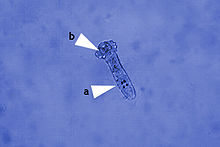- Dactylogyrus
-
Dactylogyrus 
Scientific classification Kingdom: Animalia Phylum: Platyhelminthes Class: Monogenea Order: Monopisthocotylea Family: Dactylogyridae Genus: Dactylogyrus
Diesing, 1850Dactylogyrus is a genus of the Dactylogyridae family. They are commonly known as gill flukes
Like other monogeneans, Dactylogyrus only has one host required to complete its life cycle.
Contents
Introduction
Dactylogyrus (common name: Gill Fluke) are oviparous monogeneans that have two pairs of anchors. These anchors can be used to latch onto the gills of a host, particularly freshwater fish such as carp. In heavily infected fish, Dactylogyrus can also be found on the buccal cavity. Other characteristics of the Dactylogyrus include the appearance of four eye-spots, 14 marginal hooks, one to two connective bars and two needle-like structures and spindle-shaped dactylogyrid-type seminal vesicles.[1]
Life cycle
The Dactylogyrus life cycle is direct, having no intermediate host. The hermaphroditic adults are oviparous and produce eggs into the water which hatch prior to attaching to the gills of a fish host and developing into an onchomiricidium.[2]
After the eggs hatch, water currents aid the free-swimming ciliated larva in reaching its host. The time required for egg maturation into the adult form is temperature dependent. Water temperatures of 72–75°F allow life cycle completion in a few days, whereas temperatures of 34–36°F extend the generation time to five or six months.[3]
Prevalence
Dactylogyrus is a monogean parasite that is usually found on the gills of Cyprinidae fishes.[4] The prevalence of Dactylogyrus infection on fish differ depending on the seasons. It was found that Dactylogyrus infections are at their greatest during late autumn or early winter.[5] Correlation has also been found between the temperature of the water and the intensity of Dactylogyrus infection.[6]
It is also generally accepted that fish are exposed to increased Dactylogyrus infections during their spawning period.[6]
Symptoms
Cyprinidae that are infected by Dactylogyrus may have symptoms that include inflamed gills, excessive mucous secretions and accelerated respiration. The infected fish also becomes lethargic, swims near the surface, and its appetite decreases.[7] Additionally the infected fish may hold its gill covers open and scratch its gills on rocks.[8]
In severe infections, Dactylogyrus can cause hemorrhaging and metaplasia of the gills which can lead to secondary bacterial infections and death. Heavily infected fish are also anorexic and can be found gasping for air and exhibiting abnormal behavior such as jumping out of the water.[9]
Treatment
A primary method for control of Dactylogyrus is the application of chemicals. Treatment include salt baths, formalin or organophosphates, Bromex-50 and potassium permanganate.[9]
References
- ^ Woo, P.T.K, David W. Bruno, L. H. Susan Lim. Diseases and Disorders of Finfish in Cage Culture. Malaysia: CABI, 2002. Dactylogyrus has an adult structure that is up to 2 mm long. Pond Life: Fish Health: Skin Flukes. 2007. Pond Life. 15 May 2009. http://pond-life.me.uk/fishhealth/gyrodactylus.php.
- ^ Moeller Jr., Robert B. "Miscellaneous Parasites of Fish." Cichlid-Forum.com. California Animal Health and Food Safety Laboratory System University of California. 17 May 2009 <http://www.cichlid-forum.com/articles/diseases_misc_parasites.php>
- ^ Reed, Peggy A., Ruth Francis-Floyd, and Ruthellen C. Klinger. "FA28/FA033: Monogenean Parasites of Fish." EDIS - Electronic Data Information Source - UF/IFAS Extension. University of Florida. 17 May 2009 <http://edis.ifas.ufl.edu/FA033>
- ^ Koskivaara, M., Valtonen, E. T. & Prost,M. (1991) Dactylogyrids on the gills of roach in Central Finland: Features of infection and species composition. Int. J. Parasitol. 21: 565–572.
- ^ Öztürk, M. O. and Altunel, F. N. (2006.) Occurrence of Dactylogyrus infection linked to seasonal changes and host fish size on four Cyprinid fishes in Lake Manyas, Turkey. Acta Zoologica Academiae Scientiarum Hungaricae 52 (4), pp. 407–415, 2006.
- ^ a b Hanzelová, V. & Žitnan, R. (1985) Epizootiologic importance of the concurrent monogenean invasion in carp. J. Helminthologia 22: 277–283.
- ^ Reed, Peggy A., Ruth Francis-Floyd, and Ruthellen C. Klinger. "FA28/FA033: Monogenean Parasites of Fish." EDIS - Electronic Data Information Source - UF/IFAS Extension. University of Florida. 17 May 2009 <http://edis.ifas.ufl.edu/FA033>
- ^ Dawes, John. Complete Encyclopedia of the Freshwater Aquarium. Firefly Books, 2001.
- ^ a b Woo, P.T.K, David W. Bruno, L. H. Susan Lim. Diseases and Disorders of Finfish in Cage Culture. Malaysia: CABI, 2002.
Categories:- Monogenoidea
Wikimedia Foundation. 2010.
